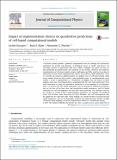Files in this item
Impact of implementation choices on quantitative predictions of cell-based computational models
Item metadata
| dc.contributor.author | Kursawe, Jochen | |
| dc.contributor.author | Baker, Ruth E. | |
| dc.contributor.author | Fletcher, Alexander G. | |
| dc.date.accessioned | 2019-08-08T12:30:03Z | |
| dc.date.available | 2019-08-08T12:30:03Z | |
| dc.date.issued | 2017-09-15 | |
| dc.identifier | 260459850 | |
| dc.identifier | ee0ea09b-810c-45c5-ab7d-e98c37b3737f | |
| dc.identifier | 85020694371 | |
| dc.identifier.citation | Kursawe , J , Baker , R E & Fletcher , A G 2017 , ' Impact of implementation choices on quantitative predictions of cell-based computational models ' , Journal of Computational Physics , vol. 345 , pp. 752-767 . https://doi.org/10.1016/j.jcp.2017.05.048 | en |
| dc.identifier.issn | 0021-9991 | |
| dc.identifier.other | ORCID: /0000-0002-0314-9623/work/60427777 | |
| dc.identifier.uri | https://hdl.handle.net/10023/18275 | |
| dc.description.abstract | ‘Cell-based’ models provide a powerful computational tool for studying the mechanisms underlying the growth and dynamics of biological tissues in health and disease. An increasing amount of quantitative data with cellular resolution has paved the way for the quantitative parameterisation and validation of such models. However, the numerical implementation of cell-based models remains challenging, and little work has been done to understand to what extent implementation choices may influence model predictions. Here, we consider the numerical implementation of a popular class of cell-based models called vertex models, which are often used to study epithelial tissues. In two-dimensional vertex models, a tissue is approximated as a tessellation of polygons and the vertices of these polygons move due to mechanical forces originating from the cells. Such models have been used extensively to study the mechanical regulation of tissue topology in the literature. Here, we analyse how the model predictions may be affected by numerical parameters, such as the size of the time step, and non-physical model parameters, such as length thresholds for cell rearrangement. We find that vertex positions and summary statistics are sensitive to several of these implementation parameters. For example, the predicted tissue size decreases with decreasing cell cycle durations, and cell rearrangement may be suppressed by large time steps. These findings are counter-intuitive and illustrate that model predictions need to be thoroughly analysed and implementation details carefully considered when applying cell-based computational models in a quantitative setting. | |
| dc.format.extent | 16 | |
| dc.format.extent | 1540998 | |
| dc.language.iso | eng | |
| dc.relation.ispartof | Journal of Computational Physics | en |
| dc.subject | Biophysics | en |
| dc.subject | Quantitative predictions | en |
| dc.subject | Tissue growth | en |
| dc.subject | Vertex model | en |
| dc.subject | QA Mathematics | en |
| dc.subject | QH301 Biology | en |
| dc.subject | Computer Science Applications | en |
| dc.subject | Applied Mathematics | en |
| dc.subject | Computational Mathematics | en |
| dc.subject | Modelling and Simulation | en |
| dc.subject | Numerical Analysis | en |
| dc.subject | Physics and Astronomy (miscellaneous) | en |
| dc.subject | DAS | en |
| dc.subject.lcc | QA | en |
| dc.subject.lcc | QH301 | en |
| dc.title | Impact of implementation choices on quantitative predictions of cell-based computational models | en |
| dc.type | Journal article | en |
| dc.contributor.institution | University of St Andrews. Applied Mathematics | en |
| dc.identifier.doi | https://doi.org/10.1016/j.jcp.2017.05.048 | |
| dc.description.status | Peer reviewed | en |
This item appears in the following Collection(s)
Items in the St Andrews Research Repository are protected by copyright, with all rights reserved, unless otherwise indicated.

